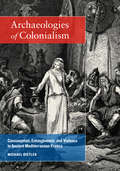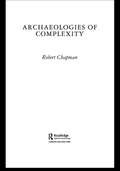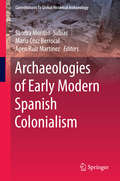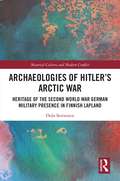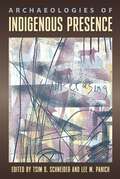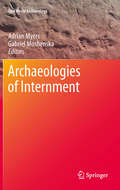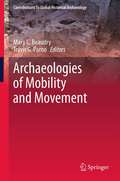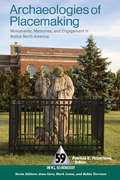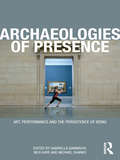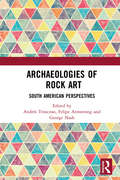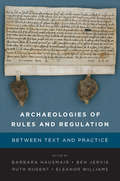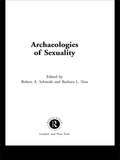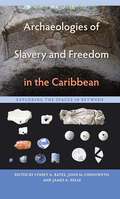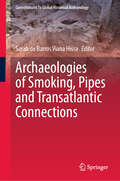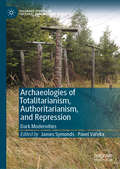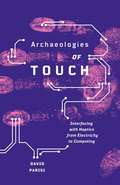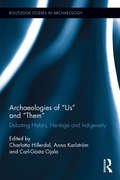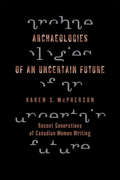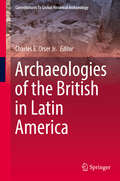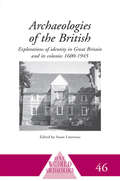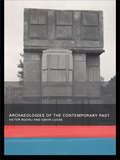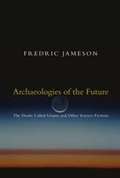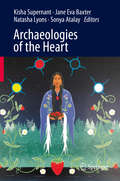- Table View
- List View
Archaeologies of Colonialism
by Michael DietlerThis book presents a theoretically informed, up-to-date study of interactions between indigenous peoples of Mediterranean France and Etruscan, Greek, and Roman colonists during the first millennium BC. Analyzing archaeological data and ancient texts, Michael Dietler explores these colonial encounters over six centuries, focusing on material culture, urban landscapes, economic practices, and forms of violence. He shows how selective consumption linked native societies and colonists and created transformative relationships for each. Archaeologies of Colonialism also examines the role these ancient encounters played in the formation of modern European identity, colonial ideology, and practices, enumerating the problems for archaeologists attempting to re-examine these past societies.
Archaeologies of Complexity: The Later Prehistory Of South-east Spain, Iberia And The West Mediterranean (New Studies In Archaeology Ser.)
by Robert ChapmanAn up-to-date and critical analysis of how archaeologists study past societies, Archaeologies of Complexity addresses the nature of contemporary archaeology and the study of social change, and debates the transition from perceived simple, egalitarian societies to the complex power structures and divisions of our modern world. Since the eighteenth century, archaeologists have examined complexity in terms of successive types of societies, from early bands, tribes and chiefdoms to states; through stages of social evolution, including 'savagery', 'barbarism' and 'civilisation', to the present state of complexity and inequality. Presenting a radical, alternative view of ancient state societies, the book explains the often ambiguous terms of 'complexity', 'hierarchy' and inequality' and provides a critical account of the Anglo-American research of the last forty years which has heavily influenced the subject.
Archaeologies of Early Modern Spanish Colonialism (Contributions To Global Historical Archaeology)
by Sandra Montón-Subías María Cruz Berrocal Apen Ruiz MartínezArchaeologies of Early Modern Spanish Colonialism illustrates how archaeology contributes to the knowledge of early modern Spanish colonialism and the "first globalization" of the 16th and 17th centuries. Through a range of specific case studies, this book offers a global comparative perspective on colonial processes and colonial situations, and the ways in which they were experienced by the different peoples. But we also focus on marginal "unsuccessful" colonial episodes. Thus, some of the papers deal with very brief colonial events, even "marginal" in some cases, considered "failures" by the Spanish crown or even undertook without their consent. These short events are usually overlooked by traditional historiography, which is why archaeological research is particularly important in these cases, since archaeological remains may be the only type of evidence that stands as proof of these colonial events. At the same time, it critically examines the construction of categories and discourses of colonialism, and questions the ideological underpinnings of the source material required to address such a vast issue. Accordingly, the book strikes a balance between theoretical, methodological and empirical issues, integrated to a lesser or greater extent in most of the chapters.
Archaeologies of Hitler’s Arctic War: Heritage of the Second World War German Military Presence in Finnish Lapland (Material Culture and Modern Conflict)
by Oula SeitsonenThis book discusses the archaeology and heritage of the German military presence in Finnish Lapland during the Second World War, framing this northern, overlooked WWII material legacy from the nearly forgotten Arctic front as ‘dark heritage’ – a concrete reminder of Finns siding with the Nazis – and as polluting ‘war junk’ that ruins the ‘pristine natural beauty’ of Lapland’s wilderness. The scholarship herein provides fresh perspectives to contemporary discussions on heritage perception and ownership, indigenous rights, community empowerment, relational ontologies, and the ongoing worldwide refugee crisis.
Archaeologies of Indigenous Presence
by Lee M. Panich Tsim D. SchneiderHighlighting collaborative archaeological research that centers the enduring histories of Native peoples in North AmericaChallenging narratives of Indigenous cultural loss and disappearance that are still prevalent in the archaeological study of colonization, this book highlights collaborative research and efforts to center the enduring histories of Native peoples in North America through case studies from several regions across the continent.The contributors to this volume, including Indigenous scholars and Tribal resource managers, examine different ways that archaeologists can center long-term Indigenous presence in the practices of fieldwork, laboratory analysis, scholarly communication, and public interpretation. These conversations range from ways to reframe colonial encounters in light of Indigenous persistence to the practicalities of identifying poorly documented sites dating to the late nineteenth century.In recognizing Indigenous presence in the centuries after 1492, this volume counters continued patterns of unknowing in archaeology and offers new perspectives on decolonizing the field. These essays show how this approach can help expose silenced histories, modeling research practices that acknowledge Tribes as living entities with their own rights, interests, and epistemologies.
Archaeologies of Internment (One World Archaeology)
by Gabriel Moshenska Adrian MyersThe internment of civilian and military prisoners became an increasingly common feature of conflicts in the twentieth century and into the twenty-first. Prison camps, though often hastily constructed and just as quickly destroyed, have left their marks in the archaeological record. Due to both their temporary nature and their often sensitive political contexts, places of internment present a unique challenge to archaeologists and heritage managers. As archaeologists have begun to explore the material remains of internment using a range of methods, these interdisciplinary studies have demonstrated the potential to connect individual memories and historical debates to the fragmentary material remains. Archaeologies of Internment brings together in one volume a range of methodological and theoretical approaches to this developing field. The contributions are geographically and temporally diverse, ranging from Second World War internment in Europe and the USA to prison islands of the Greek Civil War, South African labor camps, and the secret detention centers of the Argentinean Junta and the East German Stasi. These studies have powerful social, cultural, political, and emotive implications, particularly in societies in which historical narratives of oppression and genocide have themselves been suppressed. By repopulating the historical narratives with individuals and grounding them in the material remains, it is hoped that they might become, at least in some cases, archaeologies of liberation.
Archaeologies of Mobility and Movement (Contributions To Global Historical Archaeology #35)
by Mary C Beaudry Travis G. ParnoThis collection of essays in Archaeologies of Mobility and Movement draws inspiration from current archaeological interest in the movement of individuals, things, and ideas in the recent past. Movement is fundamentally concerned with the relationship(s) among time, object, person, and space. The volume argues that understanding movement in the past requires a shift away from traditional, fieldwork-based archaeological ontologies towards fluid, trajectory-based studies. Archaeology, by its very nature, locates objects frozen in space (literally in their three-dimensional matrices) at sites that are often stripped of people. An archaeology of movement must break away from this stasis and cut new pathways that trace the boundary-crossing contextuality inherent in object/person mobility. Essays in this volume build on these new approaches, confronting issues of movement from a variety of perspectives. They are divided into four sections, based on how the act of moving is framed. The groups into which these chapters are placed are not meant to be unyielding or definitive. The first section, "Objects in Motion," includes case studies that follow the paths of material culture and its interactions with groups of people. The second section of this volume, "People in Motion," features chapters that explore the shifting material traces of human mobility. Chapters in the third section of this book, "Movement through Spaces," illustrate the effects that particular spaces have on the people and objects who pass through them. Finally, there is an afterward that cohesively addresses the issue of studying movement in the recent past. At the heart of Archaeologies of Mobility and Movement is a concern with the hybridity of people and things, affordances of objects and spaces, contemporary heritage issues, and the effects of movement on archaeological subjects in the recent and contemporary past.
Archaeologies of Placemaking: Monuments, Memories, and Engagement in Native North America (One World Archaeology Ser. #59)
by Patricia E. RubertoneThis collection of original essays explores the tensions between prevailing regional and national versions of Indigenous pasts created, reified, and disseminated through monuments, and Indigenous peoples’ memories and experiences of place. The contributors ask critical questions about historic preservation and commemoration methods used by modern societies and their impact on the perception and identity of the people they supposedly remember, who are generally not consulted in the commemoration process. They discuss dichotomies of history and memory, place and displacement, public spectacle and private engagement, and reconciliation and re-appropriation of the heritage of indigenous people shown in these monuments. While the case studies deal with North American indigenous experience—from California to Virginia, and from the Southwest to New England and the Canadian Maritime—they have implications for dealings between indigenous peoples and nation states worldwide. Sponsored by the World Archaeological Congress.
Archaeologies of Presence
by Michael Shanks Gabriella Giannachi Nick KayeArchaeologies of Presence is a brilliant exploration of how the performance of presence can be understood through the relationships between performance theory and archaeological thinking. Drawing together carefully commissioned contributions by leading international scholars and artists, this radical new work poses a number of essential questions: What are the principle signifiers of theatrical presence? How is presence achieved through theatrical performance? What makes a memory come alive and live again? How is presence connected with identity? Is presence synonymous with 'being in the moment'? What is the nature of the ‘co-presence’ of audience and performer? Where does performance practice end and its documentation begin? Co-edited by performance specialists Gabriella Giannachi and Nick Kaye, and archaeologist Michael Shanks, Archaeologies of Presence represents an innovative and rewarding feat of interdisciplinary scholarship.
Archaeologies of Rock Art: South American Perspectives
by Andrés Troncoso Felipe Armstrong George NashRock art in South America is as diverse as the continent itself. In this vast territory, different peoples produced engravings, paintings, and massive earthworks, from the Atacama to the Amazon. These marks on the landscape were made by all different kinds of peoples, from some of the earliest hunter-gatherers in the continent, to the very complex societies within the Inca Empire. This book brings together the work of specialists from throughout the continent, addressing this diversity, as well as the variety of approaches that the Archaeology of rock art has taken in South America. Constructed of eleven thought-provoking chapters and arranged in three thematic sections, the book presents different theoretical approaches that are currently being used to understand the roles rock art played in prehistoric communities. The editors have skillfully crafted a book that presents the contribution the study of South American rock art can offer to the global research of this materiality, both theoretically and methodologically. This book will interest a broad range of scholars researching in archaeology, anthropology, history of art, heritage and conservation, as well as undergraduate and postgraduate students who will find interesting case studies showcasing the diverse ways in which rock art can be approached. Despite its focus on South America, the book is intended as a contribution towards the global study of rock art.
Archaeologies of Rules and Regulation: Between Text and Practice
by Barbara Hausmair Ben Jervis Ruth Nugent Eleanor WilliamsHow can we study the impact of rules on the lives of past people using archaeological evidence? To answer this question, Archaeologies of Rules and Regulation presents case studies drawn from across Europe and the United States. Covering areas as diverse as the use of space in a nineteenth-century U.S. Army camp, the deposition of waste in medieval towns, the experiences of Swedish migrants to North America, the relationship between people and animals in Anglo-Saxon England, these case studies explore the use of archaeological evidence in understanding the relationship between rules, lived experience, and social identity.
Archaeologies of Rules and Regulation: Between Text and Practice
by Eleanor Williams Barbara Hausmair, Ben Jervis, Ruth NugentHow can we study the impact of rules on the lives of past people using archaeological evidence? To answer this question, Archaeologies of Rules and Regulation presents case studies drawn from across Europe and the United States. Covering areas as diverse as the use of space in a nineteenth-century U.S. Army camp, the deposition of waste in medieval towns, the experiences of Swedish migrants to North America, the relationship between people and animals in Anglo-Saxon England, these case studies explore the use of archaeological evidence in understanding the relationship between rules, lived experience, and social identity.
Archaeologies of Sexuality: Race And Sexuality In Colonial San Francisco
by Barbara L. Voss Robert A. SchmidtStatus, age and gender have long been accepted aspects of archaeological enquiry, yet it is only recently that archaeologists have started seriously to consider the role of sex and sexuality in their studies.Archaeologies of Sexuality is a timely and pioneering work. It presents a strong, diverse body of scholarship which draws on locations as varied as medieval England, the ancient Maya kingdoms, New Kingdom Egypt, prehistoric Europe, and convict-era Australia, demonstrating the challenges and rewards of integrating the study of sex and sexuality within archaeology.This volume, with contributions by many leading archaeologists, will serve both as an essential introduction and a valuable reference tool for students and academics.
Archaeologies of Slavery and Freedom in the Caribbean: Exploring the Spaces in Between ( Florida Museum of Natural History: Ripley P. Bullen Series)
by Lynsey A. Bates, John M. Chenoweth and James A. DelleCaribbean plantations and the forces that shaped them--slavery, sugar, capitalism, and the tropical, sometimes deadly environment--have been studied extensively. This volume brings together alternate stories of sites that fall outside the large cash-crop estates. Employing innovative research tools and integrating data from Dominica, St. Lucia, the Dominican Republic, Jamaica, Barbados, Nevis, Montserrat, and the British Virgin Islands, the contributors investigate the oft-overlooked interstitial spaces where enslaved Africans sought to maintain their own identities inside and outside the fixed borders of colonialism. Despite grueling work regimes and social and economic restrictions, people held in bondage carved out places of their own at the margins of slavery's reach. These essays reveal a complex world within and between sprawling plantations--a world of caves, gullies, provision grounds, field houses, fields, and the areas beyond them, where the enslaved networked, interacted, and exchanged goods and information. The volume also explores the lives of poor whites, Afro-descendant members of military garrisons, and free people of color, demonstrating that binary models of black slaves and white planters do not fully encompass the diversity of Caribbean identities before and after emancipation. Together, the analyses of marginal spaces and postemancipation communities provide a more nuanced understanding of the experiences of those who lived in the historic Caribbean, and who created, nurtured, and ultimately cut the roots of empire. A volume in the Florida Museum of Natural History: Ripley P. Bullen Series
Archaeologies of Smoking, Pipes and Transatlantic Connections (Contributions To Global Historical Archaeology)
by Sarah de Barros Viana HissaThis volume presents a global study of the economic and cultural global systems in which smoking materials, practices and ideas circulate, intertwine, and transform. This book compiles original work authored by researchers from the Americas, Africa, and Europe to elicit a comparative archaeology of smoking and pipes through histories and case studies from localities and regions on both sides of the Atlantic. Consequently, the book is divided into four sections divided by region. The first chapters focus on Amerindian pipes and smoking, and these are followed by research on smoking and clay pipe use in post-17th century Europe. Chapters on the production and use of clay smoking pipes in Brazil and a reflection on the influence of pipes and smoking in Senegambia comprise the final two sections respectively. Taken together, this volume explores a wide range of issues, such as economic and cultural relations between old and new worlds; the effects of colonization in different parts of the globe; circulation of ideas, practices, and objects in hegemonic and non-hegemonic transatlantic connections; techniques and styles of making and decorating pipes; materialization and expression of ethnicities and of their blurred frontiers; changes and continuities observed in smoking materials and their inferred meanings. The book compiles fresh insights on the complex and diverse history of smoking and transatlantic economic and cultural interactions associated with it. It is of interest to both historical and pre-historical archaeologists researching material culture in several regions of the world, but also historians and anthropologists interested in material culture and global cultural systems.
Archaeologies of Totalitarianism, Authoritarianism, and Repression: Dark Modernities (Palgrave Studies in Cultural Heritage and Conflict)
by James Symonds Pavel VařekaThis book offers new insights into the mechanisms of state control, systematic repression and mass violence focused on ethnic, political, class, and religious minorities in the recent past. The geographical and temporal scope of the volume breaks new ground as international scholars foreground how contemporary archaeology can be used to enhance the documentation and interpretation of totalitarian and authoritarian regimes, to advance theoretical approaches to atrocities, and to broaden public understandings of how such regimes use violence and repression to hold on to power.
Archaeologies of Touch: Interfacing with Haptics from Electricity to Computing
by David ParisiA material history of haptics technology that raises new questions about the relationship between touch and media Since the rise of radio and television, we have lived in an era defined increasingly by the electronic circulation of images and sounds. But the flood of new computing technologies known as haptic interfaces—which use electricity, vibration, and force feedback to stimulate the sense of touch—offering an alternative way of mediating and experiencing reality. In Archaeologies of Touch, David Parisi offers the first full history of these increasingly vital technologies, showing how the efforts of scientists and engineers over the past three hundred years have gradually remade and redefined our sense of touch. Through lively analyses of electrical machines, videogames, sex toys, sensory substitution systems, robotics, and human–computer interfaces, Parisi shows how the materiality of touch technologies has been shaped by attempts to transform humans into more efficient processors of information. With haptics becoming ever more central to emerging virtual-reality platforms (immersive bodysuits loaded with touch-stimulating actuators), wearable computers (haptic messaging systems like the Apple Watch&’s Taptic Engine), and smartphones (vibrations that emulate the feel of buttons and onscreen objects), Archaeologies of Touch offers a timely and provocative engagement with the long history of touch technology that helps us confront and question the power relations underpinning the project of giving touch its own set of technical media.
Archaeologies of Us and Them: Debating History, Heritage and Indigeneity (Routledge Studies in Archaeology)
by Charlotta Hillerdal Anna Karlström Carl-Gösta OjalaArchaeologies of “Us” and “Them” explores the concept of indigeneity within the field of archaeology and heritage and in particular examines the shifts in power that occur when ‘we’ define ‘the other’ by categorizing ‘them’ as indigenous. Recognizing the complex and shifting distinctions between indigenous and non-indigenous pasts and presents, this volume gives a nuanced analysis of the underlying definitions, concepts and ethics associated with this field in order to explore Indigenous archaeology as a theoretical, ethical and political concept. Indigenous archaeology is an increasingly important topic discussed worldwide, and as such critical analyses must be applied to debates which are often surrounded by political correctness and consensus views. Drawing on an international range of global case studies, this timely and sensitive collection significantly contributes to the development of archaeological critical theory.
Archaeologies of an Uncertain Future
by Karen McphersonIn Archaeologies of an Uncertain Future, McPherson explores the memory work, alternative historiographies, and feminist aesthetics by which women writers revisit the past and reimagine the future. Grounded within critical discourses across many discplines, McPherson's analysis engages contemporary discussions about autobiographical genres, post-modern historiographies, memoirs, and literary genealogies.
Archaeologies of an Uncertain Future: Recent Generations of Canadian Women Writing
by Karen McPhersonIn Archaeologies of an Uncertain Future, McPherson explores the memory work, alternative historiographies, and feminist aesthetics by which women writers revisit the past and reimagine the future. Grounded within critical discourses across many discplines, McPherson's analysis engages contemporary discussions about autobiographical genres, post-modern historiographies, memoirs, and literary genealogies.
Archaeologies of the British in Latin America (Contributions To Global Historical Archaeology)
by Charles E. Orser Jr.This volume includes chapters by historical archaeologists engaged in original research examining the role of the British Empire in Latin America. The archaeology of Latin America is today a rapidly expanding field, with new research being accomplished every day. Currently, the vast amount of research is being focused on the Spanish Empire and its agents’ interactions with the region’s indigenous peoples. Spain, however, was not the only international power intent on colonizing and controlling Latin America. The British Empire had a smaller albeit significant role in the cultural history of Latin America. This history constitutes an important piece of the historical story of Latin America. Archaeologies of the British in Latin America presents the results of original research and begins a dialogue about the archaeology of the British Empire in Latin America by an international group of archaeological scholars. Fresh insights on the complex history of cultural interaction in one of the world’s most important regions are included. It will be of interest to historical archaeologists, Mesoamerican archaeologists engaged in pre-contact research, Latin American and global historians, Latin American anthropologists, material culture specialists, cultural geographers, and others interested in the cultural history of colonialism in general and in Latin America in particular.
Archaeologies of the British: Explorations of Identity in the United Kingdom and Its Colonies 1600-1945
by Susan LawrenceBeginning with the early English colonisation of Ireland and Virginia, the international range of contributors in Archaeology of the British examine the interplay of objects and identity in Scotland and Wales, regional England, Canada, Australia, South Africa, Cyprus, and Sri Lanka. Informed by developments in historical archaeology and by postcolo
Archaeologies of the Contemporary Past
by Gavin Lucas Victor BuchliArchaeologies of the Contemporary Past turns what is usually seen as a method for investigating the distant past onto the present. In doing so, it reveals fresh ways of looking both at ourselves and modern society as well as the discipline of archaeology.This volume represents the most recent research in this area and examines a variety of contexts including:* Art Deco* landfills* miner strikes* college fraternities* an abandoned council house.
Archaeologies of the Future: The Desire Called Utopia and Other Science Fictions
by Fredric JamesonIn an age of globalization characterized by the dizzying technologies of the First World, and the social disintegration of the Third, is the concept of utopia still meaningful? <P><P>Archaeologies of the Future, Jameson's most substantial work since Postmodernism, Or, the Cultural Logic of Late Capitalism, investigates the development of this form since Thomas More, and interrogates the functions of utopian thinking in a post-Communist age. The relationship between utopia and science fiction is explored through the representations of otherness ... alien life and alien worlds ... and a study of the works of Philip K. Dick, Ursula LeGuin, William Gibson, Brian Aldiss, Kim Stanley Robinson and more. Jameson's essential essays, including "The Desire Called Utopia," conclude with an examination of the opposing positions on utopia and an assessment of its political value today.
Archaeologies of the Heart
by Sonya Atalay Kisha Supernant Jane Eva Baxter Natasha LyonsArchaeological practice is currently shifting in response to feminist, indigenous, activist, community-based, and anarchic critiques of how archaeology is practiced and how science is used to interpret the past lives of people. Inspired by the calls for a different way of doing archaeology, this volume presents a case here for a heart-centered archaeological practice. Heart-centered practice emerged in care-based disciplines, such as nursing and various forms of therapy, as a way to recognize the importance of caring for those on whom we work, and as an avenue to explore how our interactions with others impacts our own emotions and heart. Archaeologists are disciplined to separate mind and heart, a division which harkens back to the origins of western thought. The dualism between the mental and the physical is fundamental to the concept that humans can objectively study the world without being immersed in it. Scientific approaches to understanding the world assume there is an objective world to be studied and that humans must remove themselves from that world in order to find the truth. An archaeology of the heart rejects this dualism; rather, we see mind, body, heart, and spirit as inextricable. An archaeology of the heart provides a new space for thinking through an integrated, responsible, and grounded archaeology, where there is care for the living and the dead, acknowledges the need to build responsible relationships with communities, and with the archaeological record, and emphasize the role of rigor in how work and research is conducted. The contributions bring together archaeological practitioners from across the globe in different contexts to explore how heart-centered practice can impact archaeological theory, methodology, and research throughout the discipline.
